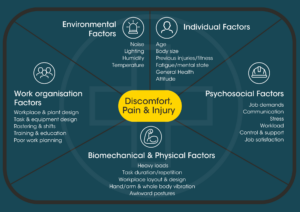Musculoskeletal disorders and the factors that might cause them
May 01, 2024

What are Musculoskeletal Disorders?
A musculoskeletal disorder is any pain felt in the muscles, bones, ligaments, tendons, blood vessels or nerves. You can feel this pain in just one area of the body, or throughout your whole body. The pain can range from mild to severe enough to interfere with your day-to-day life.
The Data
Trades workers have had the highest number of claims by occupation. According to ACC data Ligament, tendon and muscle injuries (also known as Musculoskeletal Disorders or MSDs) made up 65% of all claims. It is the most common type of injury where someone requires more than a week off work, a whopping 1,590 injured construction worker incidents were logged with WorkSafe between Jun22 and May23.
Strains and Sprains in the Construction Industry
The residential construction industry is currently booming and subsequently the ACC claim numbers and payout costs for strains and sprains are also increasing. There are numerous factors which increase the risk of musculoskeletal injuries, these include time pressure, ageing workforces and unsafe lifting techniques.
We need to change the mindsets of workers thinking that “pain and injury is unavoidable” and make our younger workforce understand the combined impacts of repeated injuries – something that more experienced builders know very well.
It is well known that there are a range of factors that contribute to MSDs. It’s not just about a single factor such as the lifting technique (although for industries such as scaffolding and roofing, lifting and handling techniques are an important factor).
The research firmly points to five groups of factors we need to tackle when addressing MSDs in construction as shown in the diagram below these are work organisation, environmental, individual, psychological, biomechanical and physical factors:

It may not surprise you that physical factors often take most of the blame as their connection is easy to understand, measure and observe. There are also proven strategies to overcome physical factors such as machinery, equipment and task modifications.
Understanding how these factors can combine and influence each other to cause problems will be crucial. Working together and combining solutions to them in your approach is where the construction industry will get the most benefit.
The most common solutions for some of the above risk factors are:
- Micropauses and position changes
- Task rotation
- Stretch warm-up and cool down
- Cardio and strength fitness/flexibility
- Stress management
- Backcare
- Communication
- Work planning
- Early reporting
We dive deeper into what treatment might look like, prevention tips, and the unseen costs associated with MSD in the blogs below:
Musculoskeletal what treatments might look like and prevention tips
5 things you can do to tackle musculoskeletal problems MSDs in your business
Musculoskeletal the hidden costs to workers lives and businesses
If you need anymore information get in touch with the HazardCo team.












